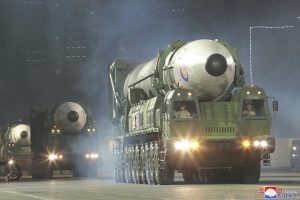North Korea held a military parade on April 25 to celebrate the 90th anniversary of the founding of the Korean People’s Revolutionary Army, the Korean Central News Agency (KCNA), the North’s state media, reported. North Korea was expected to hold a military parade at noon on Monday, but based on KCNA’s reports the parade was held at night.
Kim Jong Un, the North’s supreme leader, made a speech at the event and firmly showed off his strong will to bolster the country’s nuclear capabilities. He also ordered his officials to develop the country’s defense science and munitions industry in order to deploy “actual combat cutting-edge military hardware of new generations” to increase Pyongyang’s military power.
“In particular, the nuclear forces, the symbol of our national strength and the core of our military power, should be strengthened in terms of both quality and scale, so that they can perform nuclear combat capabilities in any situations of warfare, according to purposes and missions of different operations and by various means,” KCNA quoted Kim as saying.
To justify the country’s nuclear armament and missile tests, Kim said that his nuclear weapons are for self-defense, not to target any countries. Kim also conveyed this stance during the inter-Korean summit meetings and nuclear talks with the United States in 2018 and 2019, which sought to remove the devastating economic sanctions in exchange for the denuclearization of the Korean Peninsula. However, the nuclear talks stalled due to Washington and Pyongyang’s different views on the specific steps and extent of the denuclearization process. Since then, North Korea has readopted its old school policy against Seoul and Washington: raising the ante on the negotiating table by testing its missiles without answering their offers of dialogue.
Kim expanded the boundary of self-defense – and the circumstances for using his nuclear weapons – in yesterday’s speech, showing his clear and strong will to keep building up his nuclear weapons as a countermeasure against the threats of North Korea’s adversaries.
“The fundamental mission of our nuclear forces is to deter a war, but our nukes can never be confined to the single mission of war deterrent even at a time when a situation we are not desirous of at all is created on this land,” Kim said. “If any forces try to violate the fundamental interests of our state, our nuclear forces will have to decisively accomplish its unexpected second mission.”
Kim’s remarks may hint at an upcoming nuclear test. Based on published satellite images of North Korea’s nuclear test site at Punggye-ri, experts say Pyongyang has been restoring the site. Kim has already crossed the red line by testing a North Korean ICBM last month. Pyongyang’s next steps will likely involve either sending a reconnaissance satellite into orbit in a disguised space rocket launch to test its new ICBM system or conducting tests of other advanced ballistic missiles, such as solid fuel ballistic missiles or a submarine-launched ballistic missile (SLBM).
In the military parade, the Hwasong-17, the larger and improved version of the Hwasong-15 ICBM, was shown off along with other ballistic missiles. Experts are now analyzing the advanced missile weapons that were showcased in yesterday’s event.
North Korea claims that it successfully tested its latest Hwasong-17 ICBM on March 24, but officials in Seoul and Washington that Pyongyang tested the older Hwasong-15 ICBM to save face after a failed missile test on March 16.
Based on Pyongyang’s five-year military modernization plan, there will likely be no room to restore the stalled nuclear talks or inter-Korean dialogue. In his speech, Kim also ordered his military to be “a powerful army equipped with highly advanced military technology.”
The arms race on the Korean Peninsula looks set to intensify in coming years after Yoon Suk-yeol, the president-elect of South Korea, takes office. South Korea-U.S. joint military drills are ongoing at the moment; North Korea will likely respond to them by testing advanced missiles in coming weeks.

































